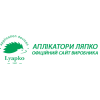Recommendations for the use of LAD "needle ball"
1 Recommendations for the use of UAL "Needle ball"
3 Using the Lyapko application device "Needle Ball"
4 Fields of application of the application device "Needle ball"
6 Methods of application of the "Needle Ball"
7 Points and zones of the application "Needle ball"
8 Applicator Lyapko "Needle ball" and Su-Jok therapy (Fig. 6)
Recommendations for the use of UAL "Needle ball"
In the brain, the centers responsible for motor skills and speech are located nearby and are closely related to each other. Developing fine motor skills of the hand, we simultaneously activate the center of speech, as well as such properties of consciousness as: attention, thinking, coordination in space, observation, imagination, motor and visual memory. Well-developed fine motor skills in preschoolers are one of the indicators of a child's readiness for schooling.
There are many techniques focused on the development of fine motor skills, which involve the use of additional tools and devices, one of which is "Needle Ball" .
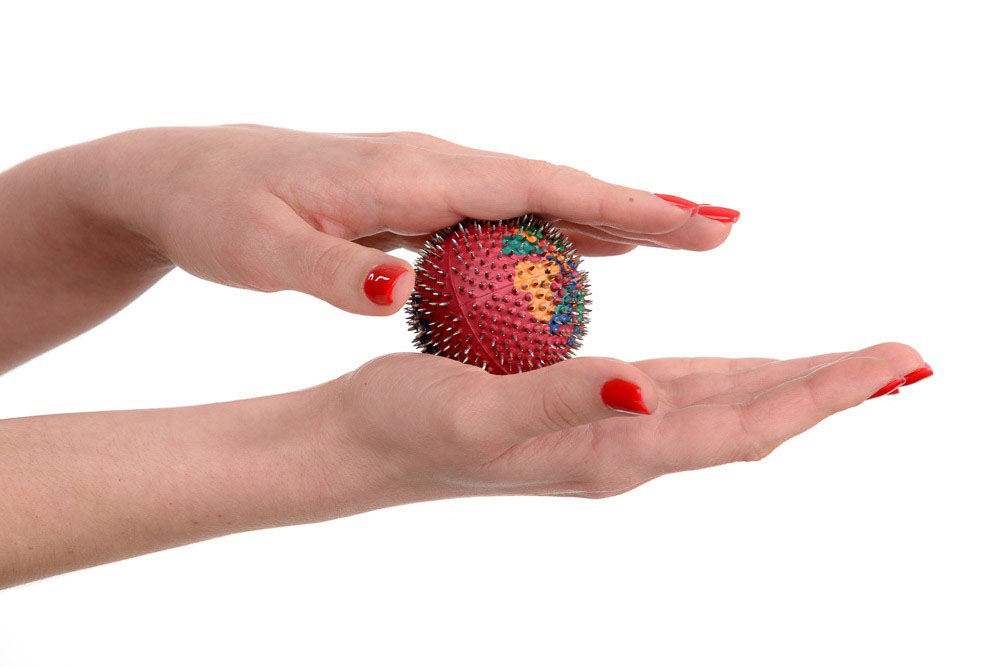
The device is a ball of rubber for medical use with a diameter of ≈ 55 mm with needles of four metals (copper, iron, silver, zinc) fixed on it. The distance between the needles is 4 mm. The total number of needles is 656 pcs.
Application therapy Lyapko
Lyapko's applicators in various modifications (plates, rollers, applique belts, applique tapes) are an original, powerful device with many health-improving therapeutic possibilities.
Their action is based on the principles of traditional Chinese medicine - superficial multi-needle acupuncture, as well as on the general physiological mechanisms of life.
Mechanisms of action of the applicator
The high healing effect of Lyapko applicators is due to a combination of intense reactions:
- reflex-mechanical;
- galvano-electric;
- immunological.
Using the Lyapko application device "Needle Ball"
In case of problems associated with impaired conduction of the nervous system and mental activity, it is necessary to act (roll, make light pressure on the palms and feet, which are projection zones of all organs and systems of the human body. Such a local effect develops fine motor skills and tactile sensitivity of the limbs, promotes development and restoration of brain functions in children and adults.
The application device Lyapko "Needle ball" is convenient to use for "finger gymnastics", widely used by child psychologists, valeologists, speech therapists, rehabilitation specialists, neuropathologists and defectologists, i.e. doctors working with children with speech delay, delayed neuromuscular, neuropsychic and psychomotor development, suffering from cerebral palsy, stuttering and other diseases.
Attention. The “needle ball” is not an expander and is not designed for strong compression in the hand, it is not a tennis ball. It is forbidden to roll the ball with your foot on the floor with strong pressure, sit, lie down, stand on it, throw it against the wall, throw it into the water.
How to work with the Needle Ball
It is recommended to make light rolling movements or light pressing in the palms, to carry out similar movements on the foot with the help of hands or to easily roll on the floor without pressure.
Fields of application of the application device "Needle ball"
- in case of damage to the articular-ligamentous apparatus of the hands and feet, to restore the motor function of the feet, hands and fingers after injuries (for example, Dupuytren's contracture, after removing the cast);
- for the "development" of muscular-articular contractures and the normalization of movements in autism, with cerebral palsy (ICP);
- with craniocerebral injuries, strokes at the stage of home rehabilitation;
- with lesions of peripheral nerves;
- with a stressful tense state of the autonomic nervous system, the predominance of the sympathetic division of the autonomic nervous system (a manifestation of which are cold hands, numb fingers);
- for the treatment of psycho-speech disorders in children (in speech therapy practice for training fine finger movements);
- for the prevention and elimination of muscle finger fatigue, preparing the hand for writing, increasing efficiency, relieving nervous tension (manifestation of nervous tension is cold hands), as a health technology in education (finger gymnastics and physical exercises at school);
- for effective prevention of carpal (carpal) syndrome (a disease that occurs with prolonged incorrect position of the hand while working with a mouse and a computer keyboard);
- to reduce the psychological craving for smoking and replace the bad habit of holding a cigarette in your hands - to do squeezes and rolling between the palms of the "Needle Ball";
- when preparing hands for playing musical instruments. Helps to relieve stiffness, tone muscles, eliminate the coldness of the fingertips caused by excitement, as well as relieve fatigue and pain in the forearm due to prolonged exercise;
- to relieve stress. When rolling the ball, nerve endings and numerous biologically active points located in the palm of your hand are stimulated. It creates a pleasant relaxing feeling.
To relieve pain and achieve the effect of inhibition (sedation), the "Needle Ball" is applied to the zones of pain or problem points from the center to the periphery counterclockwise for 15-20 minutes.
To obtain the effect of stimulation, the points of the general spectrum of action are acted upon in a clockwise direction from the periphery to the center (for 7-10 minutes).
The application device Lyapko "Needle ball" is a means of enhanced impact on the areas of pain and problem points on the human body.
To obtain a tonic effect, they act with a “Needle Ball” along the movement of energy in the channel until persistent hyperemia (redness) of the skin appears along the meridian (approximately 7-10 minutes), and to obtain a sedative effect - against the course of movement of energy in the channel until persistent skin hyperemia (approximately 10-15 minutes)
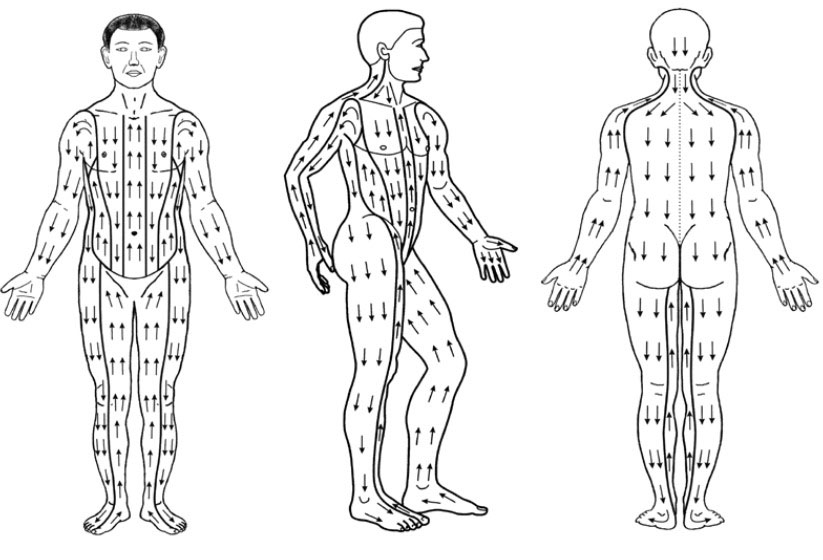
Fig.1 The course of energy channels
Ambulance
In the event of an emergency (loss of consciousness), use the “Needle Ball” for 20 seconds to act with quick tapping, stabbing movements on the tips of the fingers and toes, on the earlobes, as well as on the tip of the nose and upper lip. Pause 15 sec. and repeat these steps 2-3 times. In case of pain syndrome, apply the "Needle Ball" to the point of pain or the point of correspondence to the problem, according to the acupuncture point layouts you have, press and hold for 5-10-20 minutes.
In case of trigeminal neuralgia, facial sympathalgia and toothache - additionally apply "Needle Ball" in areas of greatest pain for 10-30 minutes. and for a short time (2-5 min.) - on the symmetrical zones of the opposite side. It is also necessary to influence the earlobe from the side of pain. To increase the effectiveness, it is necessary to briefly (1-2 minutes) act on the earlobe of the healthy side. To relieve pain after tooth extraction, act on the earlobe.
Methods of application of the "Needle Ball"
In children's practice, in case of problems associated with impaired conduction of the nervous system and mental activity, for the development of fine motor skills and tactile sensitivity, it is necessary to act (roll, make light pressure) on the palms and feet in a playful way, at a calm unhurried pace. The exposure time is 3-5 minutes.
After a stroke , to restore brain functions: improve movement in the hands, restore speech with a "Needle Ball" during the day, make light rolling movements on a soft surface with a healthy hand, hold down in a hand, put it in a sore hand. The exposure time is 7-10 minutes on the healthy side, 10-20 on the sick side.
Rolling the ball in the palms in the morning for 3-7 minutes helps relieve lethargy, drowsiness, gives a tonic effect, and increases blood pressure . Rolling for 15 minutes lowers blood pressure , relieves headaches , neck pain , calms the nervous system, use in the evening promotes good sleep .
After removing the plaster in case of fractures , injuries, damage to the articular-ligamentous apparatus of the hands and feet, roll the entire hand and foot with the Needle Ball. The duration of exposure on the side of the fracture should be longer (10-15 minutes) than on the healthy limb (3-7 minutes).
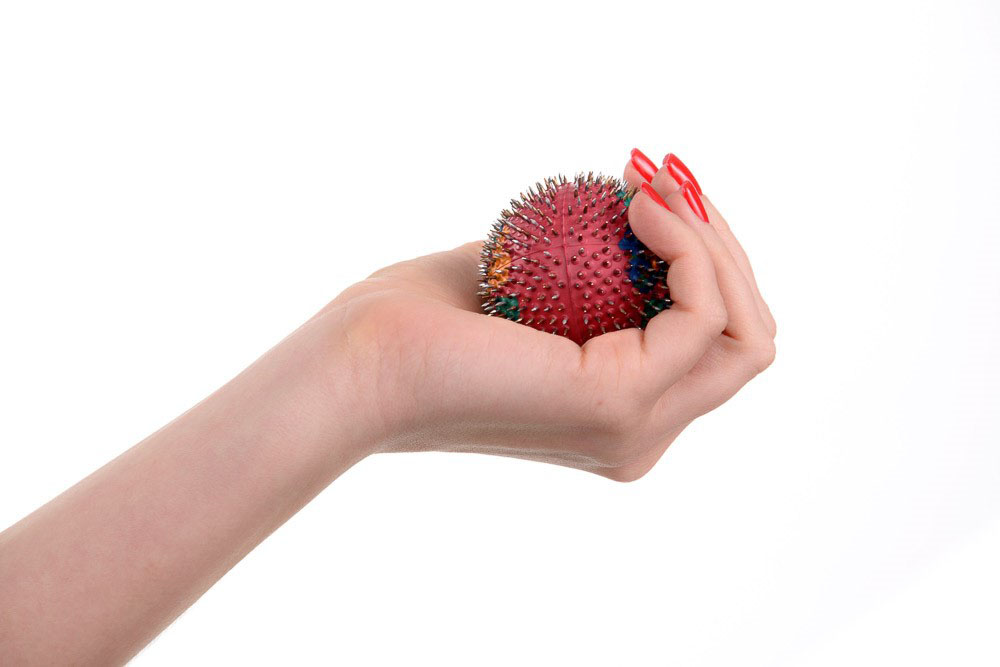
In case of pain syndrome, apply UAL “Needle Ball” to the point of pain, squeeze with your hand and hold for 15-20 minutes. You can also roll this area for 10-15 minutes. In order to potentiate (strengthen) the impact, it is necessary to include symmetrical points and zones of the opposite side in the recipe. For example, the pain zone on the left is applied on the right. Feelings should be pleasant.
Points and zones of the application "Needle ball"
on the upper limbs in various diseases and conditions (Fig. 2).
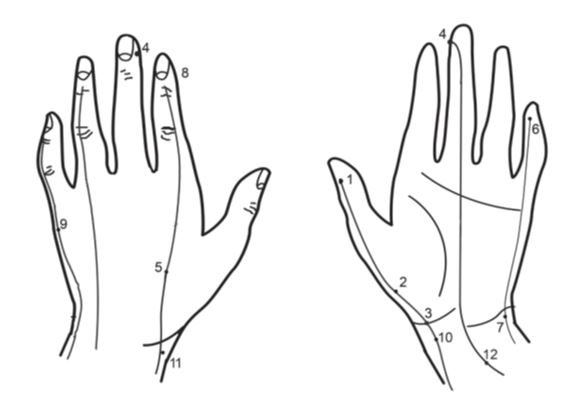
Fig.2
- Shao-shan (P11) - refers to active points, used in emergency conditions.
Indications: difficulty breathing, cough, fainting, coma, laryngitis, pharyngitis, fever, skin rashes, itching. - Yu-chi (P10) - indications: cough, choking, sore throat, pain in the chest and back, fever with headache, sleep disturbance.
- Tai Yuan (P9) - indications: shortness of breath, suffocation, dry mouth, pain in the shoulder joint, intercostal neuralgia, low blood pressure, sleep disturbance, depression, headache.
- Zhun-chun (MC9) - indications: heat stroke, pain in the heart, anxiety, headache, asthenia, memory impairment. Located in the center of the tip of the middle finger of the hand, easily accessible, used in case of loss of consciousness.
- He-gu (GI 4) - indications: neuritis of the facial nerve, tinnitus, headache, toothache, pain and swelling in the throat, nosebleeds, emergency point for a drop in blood pressure (contraindicated in pregnancy).
- Shao-chun (C9) - indications: palpitations, suffocation, pain in the region of the heart, arrhythmia, cerebrovascular accident, first aid point in case of loss of consciousness.
- Shen-men (C7) - indications: shortness of breath, pain in the heart, insomnia, memory impairment, fever.
- Shang-yang (GI 1) - indications: first aid for fainting, coma, swelling of the mucous membrane of the throat; pain in the eyes with glaucoma; tinnitus, deafness; pain in the shoulder joint and back, numbness of the fingers, fever.
- Hou-si (IG3) - a point of a wide spectrum of action. Indications: headache in the back of the head, muscle tension in the back of the head; conjunctivitis; nosebleeds, tinnitus; pain in the muscles of the shoulder; paresis of the upper limbs; epileptiform convulsions.
- Le-Que (P7) - a point of a wide spectrum of action. Indications: pain in the heart; headache in the temporal region, cough, suffocation; consequences of paralysis of the facial nerve; pain in the area of the hand, wrist, elbow joint; trigeminal neuralgia.
- Yang-si (GI 5) - indications: headache, toothache; tinnitus and deafness, rhinitis, pain and swelling of the mucous membrane of the throat; pain in the wrist and hand.
- Nei-guan (MS 6) - indications: pain in the heart, angina pectoris, tachycardia; disease of the chest cavity, cough with an asthmatic component, laryngitis; high blood pressure; belching, vomiting, pain in the stomach, in the hypochondrium; pain and cramps in the elbow and shoulder area; sleep disturbance.
Points and zones of application of the "Needle Ball" on the lower extremities in various diseases and conditions (Fig. 3)
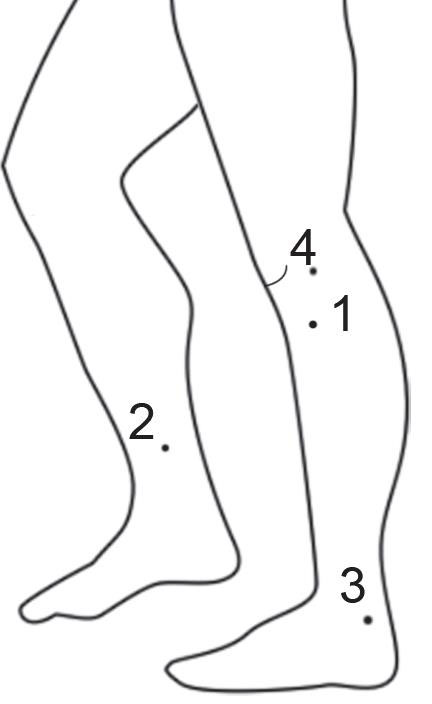
- Zu-san-li (E36) is a point of a wide spectrum of action, the only and most important for stimulating the action of the stomach and spleen. Indications: rumbling in the abdomen, flatulence, belching, fullness, bloating, diarrhea, indigestion of food (in the stool), pain in the lower abdomen, urinary incontinence, feverish conditions, general tonic effect.
- San-yin-jiao (RP6) - indications: insufficiency of stomach function, loss of appetite, diarrhea, vomiting after eating, pain in the lower abdomen, impotence, difficulty urinating, urinary incontinence, overwork.
- Kun-lun (V60) - a point of a wide spectrum of action. Indications: headache, dizziness, eye pain; nosebleeds; neck muscle tension; lower back pain with limited movement, sciatica, foot arthritis; high blood pressure, hemorrhoids.
- Yang Ling Quan (VB34) is a broad spectrum point. Indications: diseases of the liver and gallbladder; drives, cramps in the muscles of the lower extremities; sciatica, lumbago; belching, habitual constipation; dizziness, atherosclerosis.
Points and zones of application of the “Needle Ball” on the body in various diseases and conditions (Fig. 4).

Fig.4
- Da-bao (RP 21) - indications: chest pain, shortness of breath; cramps in the muscles of the limbs.
- Qu-chi (GI 11) is a broad-spectrum point. Indications: pain in the joints of the upper limbs, paralysis of the upper limbs; feverish state; pulmonary tuberculosis; violation of intestinal motility; urticaria, eczema, neurodermatitis; neurasthenia; increased blood pressure.
Points and zones of application of the “Needle Ball” in the head area for various diseases and conditions (Fig. 5)
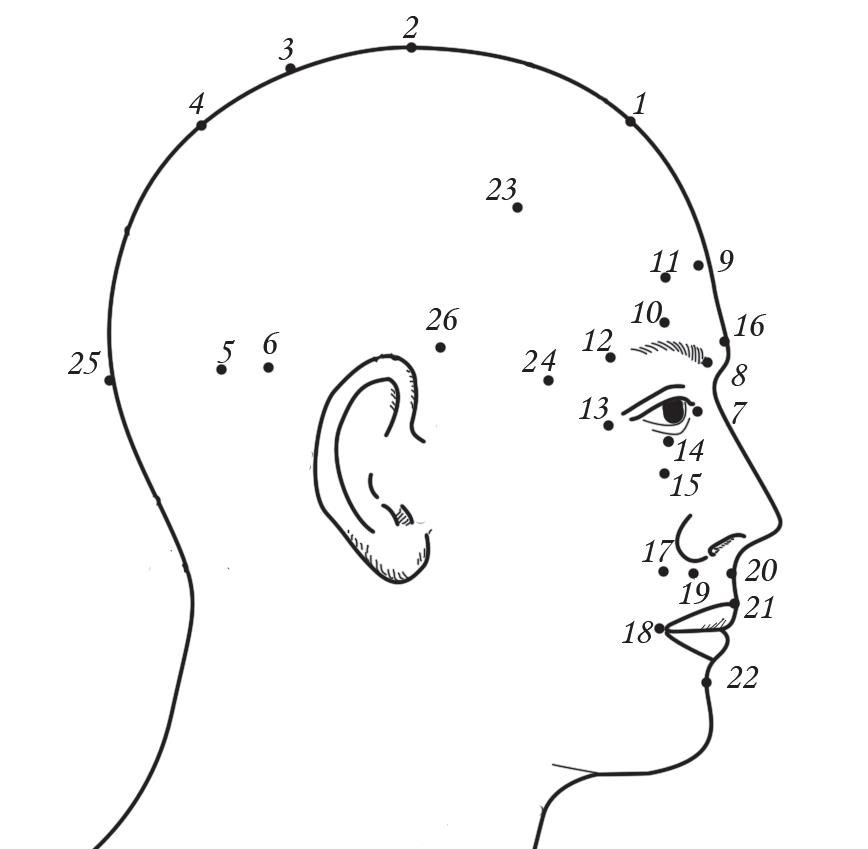
Fig.5
- Shen-ting (VG24) - indications: neuralgia of the first branch of the trigeminal nerve, dizziness, eye pain, lacrimation, nose disease, emotional instability, sleep disturbances, anxiety.
- Qian-ding (VG21) - indications: headache, dizziness, pain in the parietal region of the head, cerebrovascular insufficiency; rhinitis, epistaxis, ear diseases, convulsions, ear diseases, convulsions.
- Bai Hui (VG20) - indications: headache, dizziness, nasal congestion, tinnitus, hemorrhoids, convulsive seizures.
- Hou-ding (VG19) - indications: headache, dizziness, epistaxis, pain in the neck and neck, neck muscle stiffness; bronchial asthma.
- Nao-kun (VB19) - indications: decreased vision, shortness of breath, epistaxis, antipyretic effect, cervical sciatica, neuralgia of the occipital nerves, contracture of the cervical occipital muscles, and is also important in the treatment of eye diseases.
- Fu-bai (VB10) - indications: headache, tinnitus, paresis of the extremities, tick and contracture of the muscles of the cervical-occipital region.
- Qing-ming (V1) - indications: conjunctivitis, lacrimation.
- Quan-zhu (V2) - indications: headache, pain in the forehead, neuralgia of the first branch of the trigeminal nerve; decreased visual acuity, lacrimation, eyelid muscle tics.
- Mei-chun (V3) - indications: headache, dizziness; nasal disease, decreased sense of smell, frontal sinusitis; eye disease.
- Yu-yao (PC6) - indications: migraine, eye diseases.
- Yang Bai (VB14) - indications: headache, dizziness, vomiting; tick and spasm of mimic muscles; neuralgia and neuritis of the trigeminal and facial nerves.
- Si-zhu-kun (TR23) - indications: pain in the frontal and temporal regions, dizziness, migraine, conjunctivitis, decreased visual acuity; paresis, paralysis of the facial nerve.
- Tongzi-lyao (VB1) - indications: headache; eye diseases, lacrimation, decreased visual acuity, signs of optic nerve atrophy, glaucoma; peripheral paralysis of the facial nerve, trigeminal neuralgia.
- Cheng Qi (E1) - indications: myopia, hyperopia, lacrimation, astigmatism, optic neuritis, rhinitis, cataracts, paresis of the muscles of the eyeball.
- Sy-by (E2) - indications: conjunctivitis, glaucoma, keratitis; neuralgia of the second branch of the trigeminal nerve, paresis of the facial nerve, ptosis of the eyelid, drooping of the corner of the mouth, tic of the muscles of the upper eyelid; headache, dizziness.
- Yin-tan (PC3) - indications: headache in the forehead, dizziness; nose diseases; eye diseases; increased blood pressure.
- Ju-lyao (E3) - indications: glaucoma, lacrimation; neuralgia of the first branch of the trigeminal nerve, ptosis of the eyelid, drooping of the corner of the mouth, tic of the muscles of the eyelid; nose bleed; pain in the teeth of the upper jaw, cheeks and lips.
- Di-tsang (E4) - indications: trigeminal neuralgia, paresis of the facial nerve, tics and ptosis of the eyelid, drooping of the corner of the mouth, salivation.
- He-lyao (GI 19) - indications: decreased sense of smell, epistaxis, vasomotor rhinitis, paresis of the mimic muscles of the mouth, trismus, asthma.
- Ren-zhong (VG26) - point of resuscitation. Indications: first aid in case of loss of consciousness, convulsive hysterical seizures.
- Dui-duan (VG27) - indications: first aid in case of loss of consciousness, nosebleeds, trigeminal neuralgia.
- Cheng-jiang (VC24) - indications: neuralgia and neuritis of the lower branches of the trigeminal and facial nerves, convulsive state, swelling of the face. This point is especially important in hysterical seizures and in the provision of emergency care (collapse, diabetic coma, etc.).
- Tou-wei (E8) - indications: trigeminal neuralgia, migraine, neuritis of the facial nerve, decreased vision, conjunctivitis.
- Tai-yang (PC9) - indications: pain in the temporal region of the head, migraine, neuralgia and neuritis of the trigeminal and facial nerves, tic and contracture of facial muscles.
- Nao-hu (VG17) - located on the upper edge of the occiput (optic tubercle). Indications: headache, pain and tension of the occipital muscles; pain in the eyes, decreased visual acuity. improves the conduction of nerve impulses along the optic nerve; neurasthenia.
- Xuan-li (VВ6) - indications: pain in the temporal region of the head; toothache, swelling of the face, eye diseases;
Applicator Lyapko "Needle ball" and Su-Jok therapy (Fig. 6)
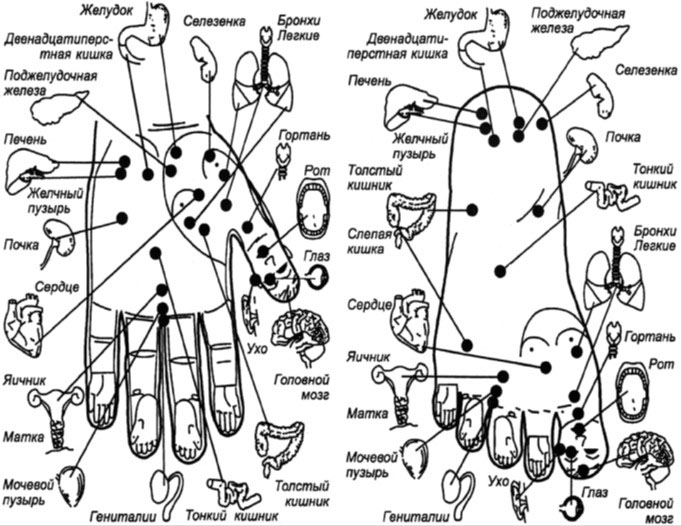
Fig.6
The impact of the “Needle Ball” on the active zones of correspondence to the organs on the palms and feet according to the Su Jok therapy method. It has a positive, healing effect on the body.
Do you have problems with any organ? Consider carefully the drawing with the correspondence scheme on the hands and feet. Determine the area with the point of correspondence to the problem organ. Attach the "Needle Ball" to this area and press, massage for several minutes. Regularly massaging the selected area on the palms and feet, you can significantly improve the condition of the diseased organ.
